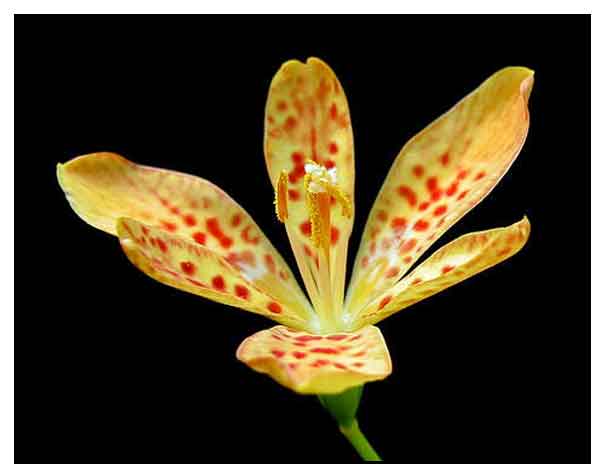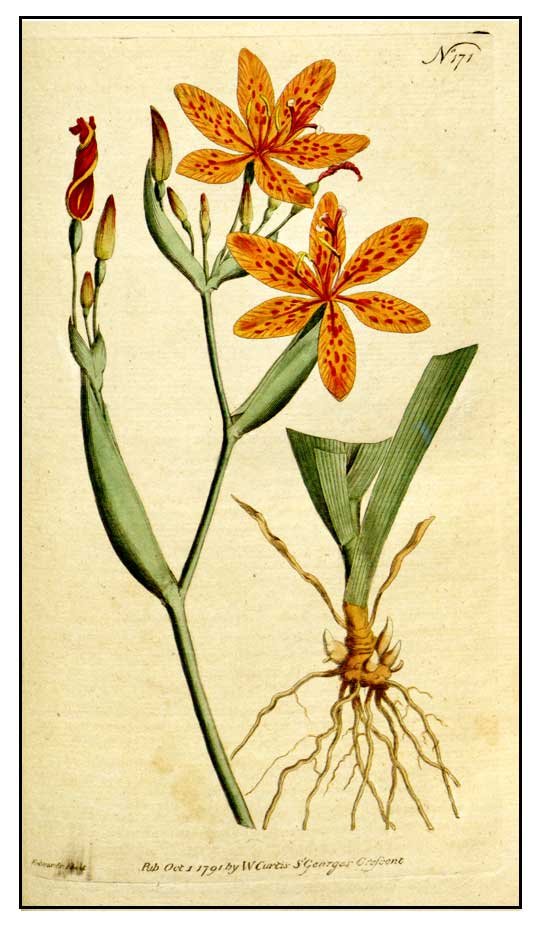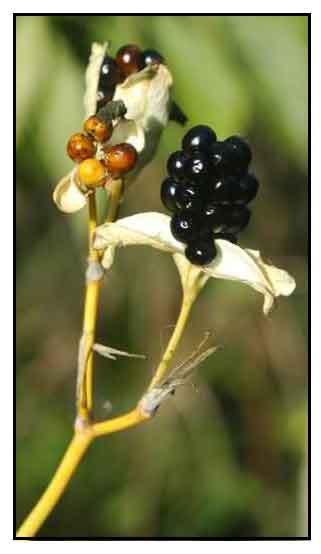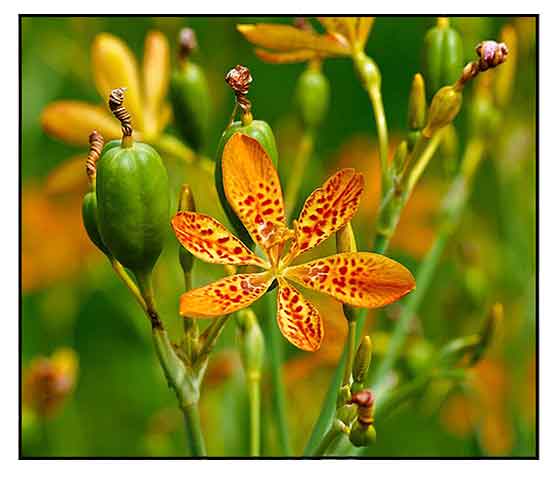 Gen info Gen info
- Iris domestica belongs to the family Iridaceae, which comprises about 60 genera and 800 species worldwide.
- Iris domestica, hi-ogi in Japan, is the floral emblem of the month-long summer Gion festival. Hi-ogi refers to the sword-shaped, iris-like, medium green leaves thought to resemble a formal, medieval Heian period court lady's fan made from cypress.
- The "blackberry" name refers to the flowers that develop into pear-shaped seed pods that split open to reveal "blackberry-like" seed cluster.
(44)
Botany
• Abaniko is an erect and tufted perennial rhizomatous herb with
a thick creeping rootstock, growing to a height of 0.5 to 1.5 meters.
Leaves are 2-ranked, strongly imbricated, narrow lanceolate, sword-shaped, 40 to 60 centimeters long, 2.5 to 4 centimeters wide,
and overlapping at the base. Inflorescence is dichotomously branched, terminal and erect. Spathes are ovate to ovate-lanceolate, about 1 centimeter long. Flowers are numerous and pedicelled, opening 1 or 2 at a time, 4 to 6
centimeters across. Perianth-tube is very short, and the segments narrowly elliptic, spreading, yellowish outside, reddish-yellow inside with reddish spots. Capsules are obovoid, membranous and loculicidal. Seeds are nearly spherical in shape, with lax and shining testa.
 • A perennial, erect, glabrous herb, 50-150 cm tall, with short, creeping, stoloniferous rhizome with round scars of old stems, usually without leaf remnants; stem corymbosely branched in the upper part. Most leaves crowded in the lower half of the stem, distichous and folding over, ensiform and obliquely linear-lanceolate, 20-60 cm × 2-4.5 cm, nearly erect, with long spathaceous base and somewhat distinct veins, vivid green to glaucous, pellucid-margined; one short leaf present at the base of each branch of stem. Inflorescence a cyme, only top branches with flowers, each cyme with 2 membranous floral sheaths (spathes), (3-)6-12 flowered. Flowers rather small, shriveling spirally after flowering; pedicel terete, 2-4 cm long, persistent, with indistinct articulation below the ovary; perianth actinomorphic, tepals short connate at base, oblong, 2-3.5 cm long, outer 3 slightly longer than inner 3, clawed, spreading, yellow outside with orange margins, bright orange with dark red blotches inside, outer tepals with longitudinal dark red nectaries at base of upper side; stamens 3, placed before the outer tepals, 1.5-2 cm long, with free filiform filaments and linear, basifixed anthers; ovary inferior, ovoid and slightly trigonous, 8-10 mm long, 3-celled, short-beaked, style about 15 mm long, orange-yellow, 3-fid with style-arms gradually thickened upwards. Fruit an oblong or obovoid, trigonous capsule with 3 deep longitudinal furrows, 1.5-3 cm long, opening with 3 loculicidal valves, many-seeded. Seeds subglobose, 4-5 mm in diameter, glossy black, remaining attached to the central placenta by the raphe for some time after the fruit opens. (41) • A perennial, erect, glabrous herb, 50-150 cm tall, with short, creeping, stoloniferous rhizome with round scars of old stems, usually without leaf remnants; stem corymbosely branched in the upper part. Most leaves crowded in the lower half of the stem, distichous and folding over, ensiform and obliquely linear-lanceolate, 20-60 cm × 2-4.5 cm, nearly erect, with long spathaceous base and somewhat distinct veins, vivid green to glaucous, pellucid-margined; one short leaf present at the base of each branch of stem. Inflorescence a cyme, only top branches with flowers, each cyme with 2 membranous floral sheaths (spathes), (3-)6-12 flowered. Flowers rather small, shriveling spirally after flowering; pedicel terete, 2-4 cm long, persistent, with indistinct articulation below the ovary; perianth actinomorphic, tepals short connate at base, oblong, 2-3.5 cm long, outer 3 slightly longer than inner 3, clawed, spreading, yellow outside with orange margins, bright orange with dark red blotches inside, outer tepals with longitudinal dark red nectaries at base of upper side; stamens 3, placed before the outer tepals, 1.5-2 cm long, with free filiform filaments and linear, basifixed anthers; ovary inferior, ovoid and slightly trigonous, 8-10 mm long, 3-celled, short-beaked, style about 15 mm long, orange-yellow, 3-fid with style-arms gradually thickened upwards. Fruit an oblong or obovoid, trigonous capsule with 3 deep longitudinal furrows, 1.5-3 cm long, opening with 3 loculicidal valves, many-seeded. Seeds subglobose, 4-5 mm in diameter, glossy black, remaining attached to the central placenta by the raphe for some time after the fruit opens. (41)
Distribution
- Native to the Philippines.
-
Planted for ornamental purposes, flowering
most of the year.
- Also native to Bangladesh, Cambodia, China, Hainan, Himalaya, India, Inner Mongolia, Japan, Korea, Malaya, Manchuria, Myanmar, Nepal, Primorye, Taiwan, Tibet, Vietnam.
- Now cultivated in most warm countries.
Properties
- Caution: Mention is made of folkloric use of root juice as abortifacient in the first trimester of pregnancy. (No studies found) (43)
-
Rhizomes are bitter and acrid.
- Traditionally considered aperient, purgative, antipyretic, diuretic, expectorant, deobstruent, carminative and resolvent.
- Pulp considered stomachic.
- Studies have shown anticancer, antifungal, antioxidant, antidiabetic, hepatoprotective, antimutagenic, anti-inflammatory, antilipidemic, antibacterial, estrogenic properties..
 Constituents Constituents
- Study yielded two major isoflavonoid glucosides: iridin and tectoridin. (1)
- Rhizomes of Belamcanda chinensis yielded three new compounds, belalloside A (1), belalloside B (2), and belamphenone (3), along with 13 known compounds, resveratrol (4), iriflophenone (5), irisflorentin (6), tectorigenin (7), irilin D (8), tectoridin (9), iristectorin A (10), iristectorin B (11), hispiduloside (12), androsin  (13), irigenin (14), iridin (15), andjaceoside (16). (see study below) (2)
- Study of ethanol extract of rhizomes yielded three compounds: isorhamnetin, hispidulin and dichotomitin. From the n-BuOH extract, iridin, tectoridin, daucosterol, vittadinoside or stigmasterol-3-O- glucoside. Four compounds were isolated from n-BuOH extracts: iridin, tectoridin, daucosterol, vittadinoside or stigmasterol-3-O-glucoside. (10)
- Ethyl acetate extract of roots isolated 18 compounds: (1), dausterol (2), quercetin (3), kaempferol (4), shikimic acid (5), gallic acid (6), ursolic acid (7), betulin (8), betulonic acid (9), betulone (10), tectoridin (11), irisflorentin (12), 4′,5,6-trihydroxy-7-methoxyisoflavone (13), tectorigenin (14), irilins A (15), iridin (16), irigenin (17), and iristectongenin A (18). (14)
- Dried rhizomes extracted with 80% ETOH and studied for isoflavones yielded 13 compounds, 10 of which were identified: tectoridin (1), acetovanillone (2), 4-hydroxy-acetophenone (3), β-sitosterol (4), β-daucosterol (5), 5,7,4'-trihydroxyl-3',5'-di methoxyflavone (6), luteolin (7), apigenin (8),5,7,4'-trihydroxyflavanones (9), isorharmnetin (10). (39)
- Ethanol extract of rhizomes yielded five compounds characterized as isoirigenin 7-O-β-D-glucoside (1), tectorigenin (2), irigenin (3), irilin D (4) and irisflorentin (5).
- Study of leaves isolated eight isoflavones viz., iristectorin A (1), iridin (2), tectoridin (3), tectorigenin (4), irisflorentin (5), genistein (6), genistin (7), and prunetin (8). (36)
Parts utilized
Rhizomes, roots, leaves.
 Uses Uses
Folkloric
- Rhizomes used as expectorant.
- Used for purifying the blood, for liver and pulmonary complaints.
- In Malaya, used as a remedy for gonorrhea.
- In Malabar, used as alexipharmic.
- In Cochin-China (Vietnam), roots used for aperient and resolvent properties.
- Used as antidote to snakebites.
- In traditional Chinese medicine, used for pharyngitis, tonsillitis, cough,
wheezing, bronchitis and mumps, blood purification, tumors of the face and breast. B. chinensis is an ingredient in the Chinese product--San Jin Xi Gua Xuang--used for sore throat, mouth and tongue ulcers.
- In Vietnam, used as diuretic. Used for swollen liver and spleen, and to treat snake bites. In Indonesia, leaves chewed with Piper betle leaves after childbirth. In Sumatra, used as poultice for lumbago. In Malaysia, rhizome used in medicinal bath after childbirth. (41)
- Root juice used as abortifacient in first trimester. (42)
Studies
• Phenolic Content / Rhizomes / Anticancer:
Three new compounds were identified–
belalloside A, belalloside B and belamphenone along with other compounds
resveratrol, iriflophenone, irisflorentine, tectoridin, among the 13
others. Compounds 3, 4, 5, 7, and 9 were shown to stimulate not only MCF-7, but also T-47E human breast cancer cell proliferation.(see constituents above) (2)
• Antifungal: A
study on the antifungal activity of Belamcanda chinensis isolated a
compound identical to tectorigenin (5,7-dihydroxy-3-(4-hydroxy phenyl)-6-methoxy-4H-1-benzopyran-4-one).
This compound showed marked antifungal activity against dermatophytes
of the genera Trichophyton. (3)
• Phytoestrogens / Anticancer:
Study demonstrated a role for tectorigenin and irigenin in regulating
the number of prostate cancer cells by inhibition of proliferation through
cell cycle regulation. (4)
• Hepatoprotective / Antioxidative:
Study of tectorigenin and tectoridin isolated from
BC rhizomes was shown to have antioxidative and hepatoprotective activities
in CCl4-intoxicated rats. (5)
• Aldose Reductase Inhibition / Tectoridin / Antidiabetic: Aldose reductase is the key enzyme in the polyol pathway, and plays an important role in diabetic complications. Study isolated 12 phenolic compounds from the rhizomes of B. chinensis, with tectoridin and tectorigenin exhibiting the highest aldose reductase inhibitory potency. Administered in STZ-induced diabetic rats, it showed significant inhibition of sorbitol accumulation in the lens, RBC and sciatic nerves. (6)
• Irigenin / Anti-Inflammatory: Study investigated the anti-inflammatory effects of six flavanoids isolated from the rhizomes of Belamcanda chinensis. Irigenin exhibited concentration-dependent inhibition of LPS-induced nitric oxide (NO) and prostaglandin (PGE2) production. (8)
• Tectorigenin / Prostate Cancer: Study of showed who tectorigenin and other compounds extracted from B. chinensis can significantly rectify the aberrant expression of genes involved in prostate cancer. Irigenin from the rhizomes presents as a leading compound for anti-inflammation. (7)
• Isoflavonoids / Antioxidant / Antimutagenic / Rhizomes: Isoflavonoid fractions from a methanolic extract of BC rhizomes inhibited chemically induced mutations in S typhimurium TA98 and TA100 and also showed capability to scavenge free radicals. Results suggest additional value of the plant as a phytoestrogenic and chemopreventive agent. (9)
• Phytoestrogens / Regulation of Steroid Receptors and Co-Factors in Prostate Cancer Cells: BCE showed beneficial effects on prostate cancer and rectifies the expression of key elements in hormone-refractory prostate cancer affecting tumor cell viability and proliferation. (13)
• Antitumor Activities / Roots: Study of ethyl acetate extract of roots isolated 18 compounds.
Shikimic acid, betulin, betulonic acid and betulone showed potent cytotoxic activities against tumor cell lines. Compound 7 suggested a mechanisms of growth inhibition via induction of tumor cell apoptosis. (See constituents above) (14)
• Hypoglycemic / Leaves: Study of Bc leaf extract on normal and STZ-induced diabetic rats showed significant lowering of fasting blood glucose levels. Results suggest the isoflavone glycosides, not polysaccharides, to be the active fraction of BCL in diabetes treatment. (15)
• Antitumor / Antioxidant / Roots: Various extracts of BC root were studied for in vitro antitumor activity against PC3, Bcap-37, and BGC-823 cell lines. Results showed an ethyl acetate extract and isolated fractions to have significant antitumor activity against the three cell lines. It also showed moderate DPPH free radical scavenging effects. (16)
• α-Glucosidase Inhibiting Isoflavones / Leaves: Alpha-glucosidase inhibitors antagonize the activity of α-glucosidase, delaying absorption of carbohydrates and preventing the sharp increases in blood sugars after meals. Study evaluated the α-glucosidase inhibitory effect of BCL. Thirteen isoflavones were isolated. Six of the thirteen (swertisin, 2"-O-rhamnosylswertisin, genistein, genistin, mangiferin and daidzin) showed strong α-glucosidase inhibitory activity in vitro. Swertisin was the most abundant of the isoflavones and may be the principal component responsible for the α-glucosidase inhibition. (17)
• Anti-Inflammatory / Inhibiting Isoflavones / Leaves: Study screened Formosan plants and Chinese herbs for anti-inflammatory activity. B. chinensis was found to be one of the active species. Study isolated two new isoflavone derivatives, 5-hydroxy-3′-methoxy-6,7:4′,5′-bis(methylenedioxy)isoflavone (1) and 5,7-dihydroxy-6,3′-dimethoxy-4′,5′-methylenedioxyisoflavone (2), along with 8 known compounds (3-10). Compound 9, isotectorigenin, exhibited potent inhibition of elastase release by human neutrophils in response to Met-Leu-Phe/Cytochalasin B. (18)
• Tectorigenin Monohydrate / Isoflavone: Study isolated a tectorigenin monohydrate, an isoflavone, 5,7-dihydroxy-3-(4- hydroxyphenyl)-6-methoxy-4H-chromen-4-one monohydrate, which showed to have antimicrobiotic and anti-inflammatory effects. (19)
• Tissue Specific Metabolites: Study showed the hydrophobic compounds, especially flavonoid or isoflavonoid aglycones and xanthone mainly accumulate in the cork, while the hydrophilic compounds, namely the flavonoid and isoflavonoid glycosides are usually found in the cortex or center. (20)
• Anti-Hyperlipidemic / Leaves: Study evaluated the anti-hyperlipidemic effect of flavone-rich leaf extract of B. chinensis in mice fed a high fat diet. Results showed alleviation of hyperlipidemia, at least in part, by up-regulation mechanisms of AMPK and PPARα. (21)
• Tectorigenin / Antibacterial / Anti-MRSA: Tectorigeninc (TTR) is an O-methylated isoflavone from the rhizome of B. chinensis. Study showed TTR has anti-MRSA (methicillin resistant Staphylococcus aureus) activity. TTR has a role in increasing cytoplasmic membrane permeability and decreasing activity of ABC transporter. Results suggest a potential for the use of TTR-based products in the treatment of MRSA. (22)
• Phytoestrogens / Antiproliferative / Prostate Cancer Cells: Phytoestrogens are nonsteroidal plant derived compounds with estrogenic activity that have been implicated in protecting against prostate cancer progression. In vitro studies showed a role for tectorigenin and irigenin in regulating prostate cancer cell number by inhibiting proliferation through cell cycle regulation. (23)
• Inhibitory Effects on Nitric Oxide Production: Study of methyl chloride fraction of rhizomes yielded 17 compounds. The isolated compounds were evaluated for inhibitory effects on nitric oxide production in LPS-induced RAW 264.7 macrophage cells. (24)
• Analgesic / Anti-Inflammatory / Toxicity Evaluation / Tectorigenin: Tectorigenin is a main compound of B. chinensis. On subacute toxicity testing in mice, no toxic symptoms were observed at doses up to 300 mg/kg. It showed an analgesic effect on acetic acid-induced acute visceral pain in mice, and significant reduction of carrageenan-induced edema in an inflammatory rat model. Â (25)
• Tectorigenin / Anti-Proliferative / Malignant Testicular Germ Cell Tumors: Study demonstrated the potential of B. chinensis extract and tectorigenin as anticancer drugs in cell lines of malignant testicular germ cell tumor cells (TGCT) by inhibition of proliferation and regulating the expression of stem cell factors. The effects may be based on histone-dependent mechanisms such as direct hyperacetylation of transcription factors. (26)
• Irisflorentin / Reduction of Allergic Contact Hypersensitivity Responses / Roots: Irisflorentin in an isoflavone component derived from the roots of B. chinensis. Study investigated the effects of irisflorentin on lipopolysaccharide (LPS)-stimulated maturation of mouse bone marrow-derived DCs (dendritic cells). Results showed irisflorentin can improved CHSR by blocking DC function. Study provides insight into potential role of irisflorentin as an immunotherapeutic adjuvant through its ability to modulate the properties of dendritic cells. (27)
• In Vitro Estrogenic Activities: Study evaluated the estrogenic activities of 70% EtOH extracts of 32 traditional Chinese medicinal plants. Belamcanda chinensis, P. corylifolia and P. multiflorum showed a higher estrogenic relative inductive efficiency with RIE ranging from 83.7 to 52.1 (RIE of E2 was 100). Â (28)
• Anti-Osteoporotic Effects: Study evaluated the effect of medicinal herbs on osteoporosis, especially induced by estrogen deficiency, in an animal model. The B. chinensis extract containing tectorigenin had a strong hypothalamotropic and osteotropic effect without effects on the uterus or the mammary gland. Â (29)
• Anti-Trypanosomal Iridals: Study evaluated 196 extracts from traditional Chinese plants for potential to treat trypanosomal diseases. Bioassay guided fractionation of petroleum ether extract of Iris domestica led to the identification of several types of iridals with previously unreported anti-trypanosomal activity. (31) Bioassay-guided fractionation identified the myristate ester of iso-iridogermanal as an antitrypanosomal component of Iris domestica. The compound has been shown to be cytotoxic to tumor cells.(34) Previously evaluated for activity against Trypanosoma brucei, bioassay-guided fractionation isolated four known iridals as active components. Chemical modification of the isolates afforded novel stable derivatives that maintained bioactivity. (35)
• Tectorigenin / Prostate Cancer Therapy: Study demonstrated the potential of plant constituents, tectorigenin and irigenin, extracted from Belamcanda chinensis as therapies in prostate cancer. Results demonstrate B. chinensis markedly inhibited the development of tumors in vivo and suggests the compounds may be useful in the prevention and treatment of human prostate cancer. (32)
• Isoflorentin / Effect on α-Synuclein Accumulation / Implications for Parkinson's Disease: PD is a degenerative disorder characterized by progressive loss of dopaminergic neurons in the substantia nigra pars compacta together with neuron impairment. Isoflorentin from the roots of Belamcanda chinensis was evaluated for its effect in amelioration of PD in Caenorhabditis elegans model. Results showed irisflorentin prevents α-synuclein accumulation in the CE model and improved dopaminergic neuron degeneration suggesting a potential as an anti-parkinsonian drug. It may exert effects by promotion of rpn-3 expression to block apoptosis pathways. (33)
• Anti-Trypanosomal Activity / Cytotoxicity: Bioassay-guided fractionation of Iris domestica isolated a myristate ester of iso-iridogermanal as an antitrypanosomal component. The compound has previously been isolated from I. domestica, as well as other Iris species, and has been shown to be cytotoxic to tumor cells. (34)
• Anti-Trypanosomal
Activity of Iridals: A petroleum ether extract of Iris domestica was evaluated for activity against Trypanosoma brucei. Bioactive-guided fractionation isolated two known iridals, iso-iridogermanal (myristate ester) (2), and anhydrobelachinal (3). The unsaturated aldehydes were reduced to corresponding alcohols, 4 and 5. Two other alcohols were obtains by direct reduction of semi-pure Fractions III and IV, to yield reduced analogs of the known iridals, 26-hydroxy-15-methylindene-spiroirid-16-enal and irodotectoral C, allylic alcohols 7 and 8. Seven of the compounds, 2-8, produced strong activity against T. brucei with IC50s of <10 µg/mL. (35)
• Anti-Inflammatory
/ BC-2 / Rhizomes: Bioassay-guided fractionation of EtOAc soluble fraction from rhizomes isolated eleven compounds (BC-1 to BC-11), and were evaluated for COX-2 expression and prostaglandin E2 (PGE2) production in Raw264.7 cells. BC-2 ((7R,8S)-dehydrodiconiferyl alcohol-9'-y-methyl ether) showed most potent inhibitory activity by suppressing LPS-induced COX-2 expression and PGE-2 production in a dose-dependent manner. Results suggest the anti-inflammatory action of BC-2 in RAW246.7 cells involves miR-146a and miR-155, and suggests potential for design of novel anti-inflammatory therapeutic agents. (37)
• Invention / Isoflavone in Anti-Tumor Drug or Food: The invention relates to the use of isoflavone compounds from the rhizome of belamcanda chinensis such as tectorigenin, wild iris genin, irisflorentin, wild iris glycoside, or tecoridin in the preparation of anti-tumor drugs or food. In vitro studies have shown the compounds to have inhibitory effects on growth of cells line A549 (human lung cancer cells), LOVO (human colon cancer cells), 6T-CEM (human T-cell leukemia cells) and HL-60 (human leukemia cells). (38)
• Iristectorigenin B
/ Liver X Receptor Modulator / Hypocholeterolemic Effects: Study isolated a novel liver X receptor (LXR) modulator, iristectorigenin B. from B. chinensis, which stimulated the transcriptional activity of both LXR-α and LXR-ß. In macrophages, iristectorigenin B suppressed cholesterol accumulation in a dose-dependent manner. Iristectorigenin B is a dual LXR agonist that regulates expression of key genes in cholesterol homeostasis in macrophage cells without inducing hepatic lipid accumulation. (40)
• Induction of Isoflavones by CuCl2: Previous studies have indicated that isoflavonoid glycosides were induced by CuCl2 in I. domestica calli. Study hypothesized that isoflavone O-UGTs may be induced by Cu2+. A comparative transciptome analysis using I. domestica seedlings treated with CuCl2 yielded eight new active BcUGTs. Real-time quantitative PCR indicated that the transcription levels of BcUGTs were remarkably induced by Cu2+. (42)
Availability
- Cultivated.
- Seeds in the cybermarket.
|



 • A perennial, erect, glabrous herb, 50-150 cm tall, with short, creeping, stoloniferous rhizome with round scars of old stems, usually without leaf remnants; stem corymbosely branched in the upper part. Most leaves crowded in the lower half of the stem, distichous and folding over, ensiform and obliquely linear-lanceolate, 20-60 cm × 2-4.5 cm, nearly erect, with long spathaceous base and somewhat distinct veins, vivid green to glaucous, pellucid-margined; one short leaf present at the base of each branch of stem. Inflorescence a cyme, only top branches with flowers, each cyme with 2 membranous floral sheaths (spathes), (3-)6-12 flowered. Flowers rather small, shriveling spirally after flowering; pedicel terete, 2-4 cm long, persistent, with indistinct articulation below the ovary; perianth actinomorphic, tepals short connate at base, oblong, 2-3.5 cm long, outer 3 slightly longer than inner 3, clawed, spreading, yellow outside with orange margins, bright orange with dark red blotches inside, outer tepals with longitudinal dark red nectaries at base of upper side; stamens 3, placed before the outer tepals, 1.5-2 cm long, with free filiform filaments and linear, basifixed anthers; ovary inferior, ovoid and slightly trigonous, 8-10 mm long, 3-celled, short-beaked, style about 15 mm long, orange-yellow, 3-fid with style-arms gradually thickened upwards. Fruit an oblong or obovoid, trigonous capsule with 3 deep longitudinal furrows, 1.5-3 cm long, opening with 3 loculicidal valves, many-seeded. Seeds subglobose, 4-5 mm in diameter, glossy black, remaining attached to the central placenta by the raphe for some time after the fruit opens. (
• A perennial, erect, glabrous herb, 50-150 cm tall, with short, creeping, stoloniferous rhizome with round scars of old stems, usually without leaf remnants; stem corymbosely branched in the upper part. Most leaves crowded in the lower half of the stem, distichous and folding over, ensiform and obliquely linear-lanceolate, 20-60 cm × 2-4.5 cm, nearly erect, with long spathaceous base and somewhat distinct veins, vivid green to glaucous, pellucid-margined; one short leaf present at the base of each branch of stem. Inflorescence a cyme, only top branches with flowers, each cyme with 2 membranous floral sheaths (spathes), (3-)6-12 flowered. Flowers rather small, shriveling spirally after flowering; pedicel terete, 2-4 cm long, persistent, with indistinct articulation below the ovary; perianth actinomorphic, tepals short connate at base, oblong, 2-3.5 cm long, outer 3 slightly longer than inner 3, clawed, spreading, yellow outside with orange margins, bright orange with dark red blotches inside, outer tepals with longitudinal dark red nectaries at base of upper side; stamens 3, placed before the outer tepals, 1.5-2 cm long, with free filiform filaments and linear, basifixed anthers; ovary inferior, ovoid and slightly trigonous, 8-10 mm long, 3-celled, short-beaked, style about 15 mm long, orange-yellow, 3-fid with style-arms gradually thickened upwards. Fruit an oblong or obovoid, trigonous capsule with 3 deep longitudinal furrows, 1.5-3 cm long, opening with 3 loculicidal valves, many-seeded. Seeds subglobose, 4-5 mm in diameter, glossy black, remaining attached to the central placenta by the raphe for some time after the fruit opens. ( Constituents
Constituents Uses
Uses

